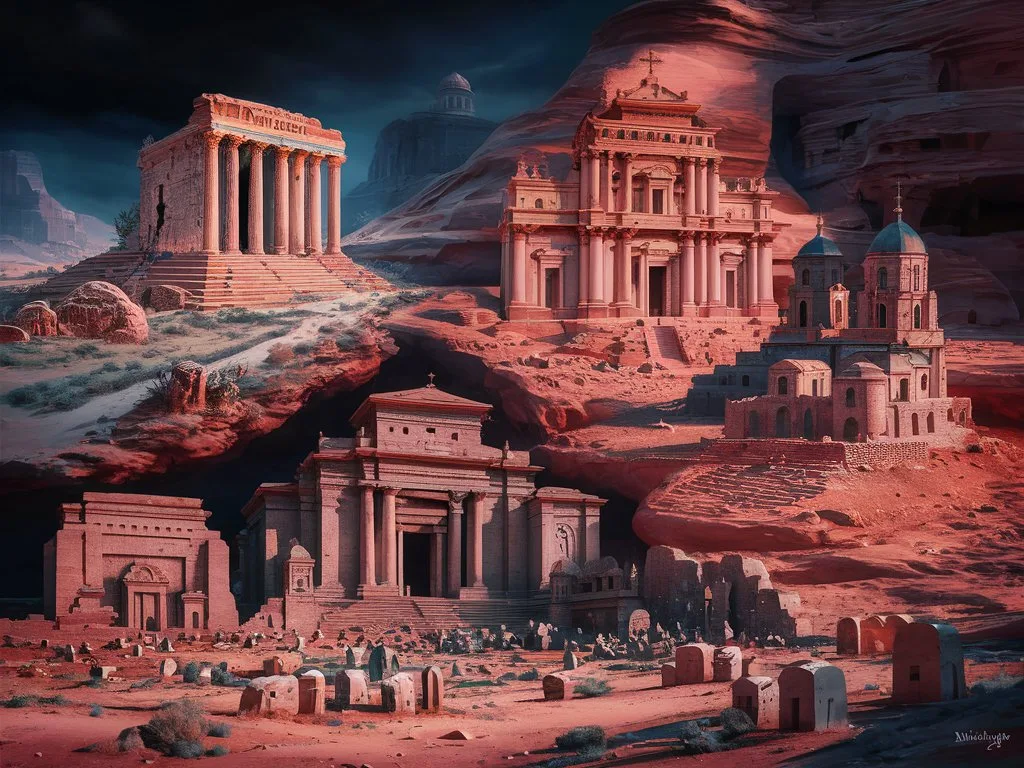Introduction to Petra Jordan: The Lost City

A. Brief Overview of Petra’s Historical Significance
Ancient Petra Jordan, famously known as the “Rose City”, was once the thriving capital of the Nabataean Kingdom. Carved into stunning rose-hued rock, this ancient city served as a bustling trading hub, linking the East and West. Merchants traversed its elaborate pathways carrying exquisite goods, such as spices and silk, making it a center of wealth and culture over 2,000 years ago. The ingenuity of the Nabataeans is evident in Petra’s sophisticated water management systems and remarkable architecture.
B. The Enigmatic Allure of Petra in Popular Culture
Petra’s captivating beauty has drawn the fascination of explorers, historians, and artists throughout the ages. The famed “Indiana Jones and the Last Crusade” film introduced this gem to a broader audience, but its appeal extends beyond cinema. The layered history, combined with the breathtaking desert landscape, invites adventurers and dreamers alike to explore its mysteries.
C. The Importance of Understanding Its Abandonment
While understanding ancient Petra Jordan’s splendor is essential, it is equally crucial to uncover why this grand city fell into ruin. The tale of its abandonment tells us about the resilience and challenges faced by a civilization, much of which resonates with modern society today.
Geographical and Environmental Challenges

A. The Harsh Desert Climate
Description of Temperature Extremes
Petra’s location in a desert environment results in extreme temperatures, with scorching summers reaching over 40°C (104°F) and frigid winters dipping below freezing. Such harsh conditions make it a challenging place for continuous human settlement.
Water Scarcity Issues
Water scarcity has plagued Petra’s inhabitants since ancient times. The Nabataeans developed advanced aqueducts and cisterns to capture and store rainwater, but prolonged droughts and climatic shifts eventually undermined their impressive systems. This scarcity significantly impacted the community’s ability to thrive.
Effects on Agriculture and Livelihood
The demanding desert climate severely limited agricultural output. Crops that depended on regular water supplies struggled to flourish, leading to mounting stress on the population. Lack of food resources forced many to abandon their homes in search of more hospitable environments.
B. Natural Disasters and Their Impact

1. Quakes and Their Consequences
The region has experienced numerous earthquakes throughout history, causing significant damage to Petra’s structures. Such natural disasters led many to flee the city, seeking refuge in safer areas.
Erosion and Its Long-term Effects
Petra’s stunning facades, sculpted from soft sandstone, are vulnerable to erosion from wind and rain. Over time, relentless weathering contributed to the physical decline of the city’s majestic structures.
Flood Risks in the Region
Petra is also at risk of flash floods, particularly during heavy rains. Historical accounts indicate that severe flooding events devastated the city, wiping out inhabitants and property, further accelerating its decline.
C. The Isolation of Petra

Difficult Terrain and Accessibility
Although once a major trade center, Petra’s remote location eventually hindered access. Difficult terrain and challenging paths made it hard for traders and travelers to reach the city, diminishing its influence.
The Role of Trade Routes in Its Decline
As global commerce evolved and shifted to more accessible maritime routes, Petra lost its position as a trade nexus. The city that had thrived on commerce became increasingly isolated, leading to significant economic decline.
Changes in Population Distribution
The decline in trade prompted many residents to seek opportunities elsewhere, resulting in a significant drop in Petra’s population. The silence of abandoned streets echoes the loss of former prosperity.
Socio-Political Factors Contributing to Abandonment

A. The Decline of Trade Networks
Shifts in Regional Trade Routes
The rise of powerful empires and the competition for trade networks caused a shift in regional commerce. Goods once flowing through Petra moved to other trade hubs, significantly diminishing the city’s economic vitality.
Competition from Other Trading Cities
As alternative cities like Palmyra gained prominence, Petra found itself increasingly marginalized. Dwindling merchant traffic transformed Petra’s once-vibrant atmosphere into a shadow of its former self.
The Rise of Maritime Trade
The shift to maritime shipping rendered overland caravan trading less critical. This change left Petra behind as economies and communities adapted, forever altering the dynamics of trade.
B. Political Instability and Conflicts

External Conquests and Their Effect
The Nabataean Kingdom faced invasions from powerful empires, notably the Romans. These conflicts disrupted trade and led to a series of governance changes that created instability.
Changes in Governance and Leadership
With new rulers and shifting political realities, trade and agricultural practices came under pressure. Distrust arose among the populace as governing bodies became disconnected from grassroots needs.
Internal Strife within the Nabataean Society
Competition for limited resources led to social tensions within the community. Fragile alliances began to collapse, contributing to Petra’s eventual decline.
C. The Fall of the Nabataean Kingdom

Roman Annexation and Its Implications
The Roman annexation marked a turning point for Petra. While some advancements in infrastructure occurred, the cultural erosion that followed left an indelible mark on the city’s identity.
Cultural Assimilation and Loss of Identity
The introduction of Roman customs diluted the unique Nabataean culture. As local traditions faded, people found it challenging to cling to their heritage and customs.
Economic Shifts Post-Conquest
Integration into the Roman economy altered the dynamics of trade in Petra. Many local goods that once sustained the economy lost importance, contributing to economic stagnation.
Shifts in Spiritual and Cultural Practices

A. The Evolution of Religious Beliefs
The Decline of Nabataean Religion
As foreign influences took hold, old Nabataean religious practices began to diminish. Once lively sanctuaries now lay silent, symbolizing an era of lost beliefs.
The Rise of Christianity and Its Influence
Christianity’s spread in the region brought new narratives that altered traditional practices. This evolution transformed sacred spaces and contributed to significant cultural shifts within Petra.
Changes in Burial Practices and Architectures
With the adaptation of different religious beliefs, architectural styles transformed. Burial practices evolved, reshaping the sacred landscape of Petra.
B. Evolving Trade Goods and Economic Structures

Changing Demand for Aromatic Resins and Spices
Shifting global trade patterns diminished demand for the aromatic goods that once enriched Petra’s markets, impacting the economy and community lifestyle.
Impact of Different Goods on Local Economy
With fewer goods being traded, Petra’s bustling marketplace gradually quieted. The consequence was a marked decline in local opportunities, leading many inhabitants to seek better prospects elsewhere.
The Consequence of Economic Irrelevance
As the economy failed to support its populace, many residents left Petra, leaving behind a legacy of empty homes and deserted streets.
C. The Role of Art and Architecture

Changes in Architectural Styles Over Time
The stunning architecture of Petra reflects changing influences over time. As cultures blended, new architectural elements emerged, further customizing the city’s identity.
The Decline in Artistic Patronage
As economic conditions worsened, resources for artistic projects dwindled. The artistic vibrancy that once thrived began to decline, leaving behind remnants of what was.
Cultural Exchange and Its Effects
While cultural exchange can enrich communities, in Petra’s case, it diluted the distinct heritage, speeding up the city’s decline.
The Role of Historical Narrative and Myth

A. Historical Documentation of Petra’s Abandonment
Accounts from Ancient Writers
Ancient historians recorded snippets of Petra’s story, hinting at its vibrant existence while offering glimpses into factors contributing to its eventual abandonment.
Archaeological Findings and Interpretations
Today, archaeologists continue to unravel Petra’s narrative through excavations, revealing mysteries that both explain and intrigue, thus painting a complex picture of abandonment.
Gaps in Historical Records
Although some records persist, an abundance remains incomplete or lost, hindering the full understanding of Petra’s history and leaving many questions unanswered.
B. Myths Surrounding Petra’s Mystique

Stories of Treasure and Lost Wealth
Legends of hidden treasures within Petra’s cliffs tempt adventurers. This intersection of myth and history fuels both interest and intrigue surrounding the ancient city.
Legends of Legendary Figures
Mythical stories about iconic travelers have contributed to Petra’s allure. The intermingling of fantasy and history continues to shape perceptions of this extraordinary location.
The Impact of Narrative on Modern Perceptions
Modern tales about Petra impact how we view its heritage. They encourage exploration while deepening appreciation for a city that once echoed with life.
C. The Influence of Modern Tourism

Tourism’s Role in Preserving or Exploiting Petra
In contemporary society, tourism has a dual role. It often generates critical resources for preservation while simultaneously posing potential threats to the cultural integrity of Petra.
Recent Discoveries and Their Meanings
Ongoing archaeological finds continually reshape our comprehension of Petra’s past. Each discovery carries the promise of new insights, helping us piece together this captivating story.
How Current Narratives Shape Global Understanding
Today’s narratives about Petra inform global perspectives, inviting respectful exploration while encouraging deeper appreciation for this ancient wonder.
Conclusions on the Abandonment of Petra

A. The Interplay of Natural and Human Factors
Petra’s abandonment is not attributable to a single cause. Instead, it was the combination of harsh environmental challenges and shifting socio-political landscapes that contributed to its fate.
B. Legacy of Petra in Contemporary Society
Today, ancient Petra Jordan endures as a UNESCO World Heritage site, embodying human creativity and resilience. It reminds us of the importance of safeguarding and appreciating our cultural heritage.
C. Reflections on Preservation and Future Considerations
As we explore the ruins and magnificent beauty of Petra, we must remain mindful of its delicate state. Ongoing preservation efforts and respectful tourism can guarantee that the tales of this extraordinary ancient city continue to inspire future generations.
FAQ
Q: What is Petra and why is it significant?
A: Petra is often referred to as the “Rose City” due to the stunning pink hues of its sandstone cliffs. Dating back to the 5th century BC, it served as a vital trading hub, strategically placed along the trade routes connecting Arabia, Egypt, and the Mediterranean. This unique location allowed Petra to flourish as a center for commerce, culture, and architecture.
The city is characterized by its intricate temples, tombs, and monuments carved directly into the rock faces. The most iconic structure, Al-Khazei (The Treasury), is a stunning example of Nabataean architecture, showcasing a blend of various cultural influences, including Hellenistic, Roman, and Arab styles.
Petra’s significance extends beyond its architectural marvels; it represents an important chapter in human history, illustrating the sophistication of ancient trade and the resilience of a civilization that adapted to its harsh environment.
Q: When was Petra abandoned and by whom?
A: Petra began to decline in the 3rd century AD, largely due to changes in trade routes and the rise of competing cities. The increasing dominance of the Roman Empire and shifting economic patterns led to its gradual abandonment. In the 6th century AD, an earthquake further devastated the city, causing significant damage to its structures and infrastructure.
By the time of the Ottoman Empire, Petra was largely forgotten by the outside world and was re-discovered by Western explorers in the 19th century. Notably, Swiss explorer Johann Ludwig Burckhardt popularized its existence in the early 1800s, drawing international attention to its historical importance.
Q: How has Petra been preserved in modern times?
A: The preservation of ancient Petra Jordan has become a priority for historians, archaeologists, and the Jordanian government. Recognizing its cultural and historical importance, several measures have been implemented to protect and preserve this archaeological treasure.
Some key preservation efforts include:
Regular Monitoring: Ongoing monitoring of the structural integrity of Petra’s buildings ensures that potential hazards are identified early.
Restoration Projects: Various restoration projects focus on rebuilding damaged structures and removing harmful vegetation that threatens the rock faces.
Visitor Management: Implementing sustainable tourism practices helps to minimize the impact of visitors on the site, ensuring that its beauty is preserved for future generations.
Education and Awareness: Raising awareness about the importance of preservation encourages visitors to respect the site and adhere to guidelines during their visit.
Q: What can visitors learn from Petra’s history?
A: Visiting ancient Petra Jordan is more than just an aesthetic experience; it offers a profound opportunity to learn about the rich history and culture of the Nabataeans. Here are several lessons that visitors can glean from their journey to this ancient city:
The Importance of Trade: Petra’s strategic location sheds light on ancient trade networks and how they facilitated cultural exchange and economic growth.
Architectural Innovation: The city showcases advanced architectural techniques and artistry, allowing visitors to appreciate the ingenuity of the Nabataeans in a harsh desert environment.
Environmental Adaptation: Petra illustrates how ancient civilizations adapted to their environment, particularly in terms of water conservation and management, which was crucial for life in an arid landscape.
Cultural Heritage: The blend of various architectural styles within Petra highlights the cultural influences that shaped the Nabataean civilization, reflecting its interactions with neighboring cultures.
Q: Are there ongoing archaeological efforts at Petra?
A: Yes, there are ongoing archaeological efforts at ancient Petra Jordan aimed at uncovering its mysteries and enhancing our understanding of its history.
Current archaeological endeavors include:
Excavation Projects: Archaeologists continue to excavate various parts of the city to reveal more about the Nabataean way of life, including domestic structures and ceremonial spaces.
Research Initiatives: Scholars are conducting research on the artifacts found at Petra, which include pottery, coins, and stone tools, to gather insights into trade practices, social structures, and daily life.
Public Engagement: Collaborations with local communities aim to involve them in preservation efforts, ensuring that the legacy of Petra is cared for by those who live nearby.
Efforts to document and analyze Petra’s architecture using modern technology—such as 3D mapping and drone surveys—are also being implemented to gain better insights into the city’s layout and construction methods.
Let’s dive into the adventure together with us…

I don’t think the title of your article matches the content lol. Just kidding, mainly because I had some doubts after reading the article.
Thanks for sharing. I read many of your blog posts, cool, your blog is very good.
Thank you for your sharing. I am worried that I lack creative ideas. It is your article that makes me full of hope. Thank you. But, I have a question, can you help me?
Can you be more specific about the content of your article? After reading it, I still have some doubts. Hope you can help me.